A “Suspended Animation” Bonus Feature
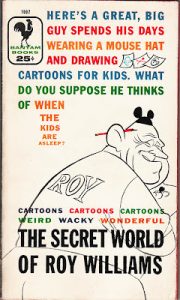 This is a continuation of a column I posted back in March. I love hunting for books and the joy of discovering a book I never knew existed. To make things more challenging, some books were self published by a vanity press or a small independent publisher in limited quantities with little or no documentation.
This is a continuation of a column I posted back in March. I love hunting for books and the joy of discovering a book I never knew existed. To make things more challenging, some books were self published by a vanity press or a small independent publisher in limited quantities with little or no documentation.
Disney Legend Roy Williams self-published a book of dark poetry about death called Vaporisms (Weather Bird Press 1967). He also produced his autobiography that I have been trying to track down for many years from the same publisher. Only 50 copies of each book were ever published. His daughter confirmed that the autobiography existed but the family does not have a copy especially since they were estranged at the time of his death.
A copy was seen at the library for Feature Animation Florida but disappeared before the person who discovered it could make a copy. Supposedly the manuscript includes stories like going on picnics at Griffith Park and getting drunk with the ink and paint girls and the notorious party at the Norconian Hotel.
It is fairly easy to find the two compilations of some of Williams’ humorous magazine cartoons: the hardcover How’s the Back View Coming? (Dutton 1949) and the paperback The Secret World of Roy Williams (Bantam Books 1957). He dedicated the paperback collection to Walt Disney. Walt and Roy pleaded with Williams to stop doing magazine cartoons because he might be giving away the best gags that they could use in the shorts and he did.
Here are a few more obscure Disney books that are animation related that you might not have in your collection:
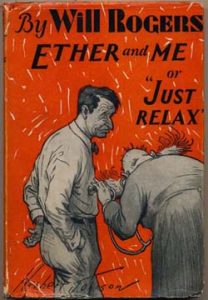 Ether and Me (or “Just Relax”) by Will Rogers (G.P. Putnam’s Sons, 1927) Within three years, there were ten different reprintings of this book so there should be plenty of copies around if you’d really like to find one. This book is of interest to Disney collectors because of the illustrations by Grim Natwick.
Ether and Me (or “Just Relax”) by Will Rogers (G.P. Putnam’s Sons, 1927) Within three years, there were ten different reprintings of this book so there should be plenty of copies around if you’d really like to find one. This book is of interest to Disney collectors because of the illustrations by Grim Natwick.
Ether and Me is more or less a short monologue in book form about the medical misadventures of one of America’s greatest humorists, Will Rogers. Rogers is not as well known to today’s audiences but in his time was a superstar.
The book is seventy-seven pages long and features fourteen pen and ink illustrations by Natwick and unless you knew Natwick’s animation background, it would be natural to assume the cartoons were done by any of the run of the mill cartoonists of the day. The drawings often feature small heads on large, angular bodies with a lot of “fussy” details like extensive crosshatching.
Natwick was also illustrating sheet music covers around the same time this book appeared.
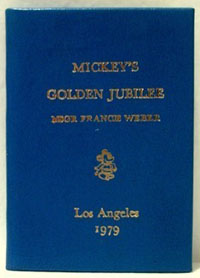 Mickey’s Golden Jubilee (published by Junipero Serra Press in 1980 and designed by Francis Braun) written by Francis Weber. This is certainly an oddball book that may be unfamiliar to Disneyphiles because it was created for the world of collectors who collect miniature books. It is only three inches by two inches with a blue cover, gold-tipped parchment like pages and a badly drawn picture of a Mickey Mouse type mouse that is reproduced at the bottom of each page.
Mickey’s Golden Jubilee (published by Junipero Serra Press in 1980 and designed by Francis Braun) written by Francis Weber. This is certainly an oddball book that may be unfamiliar to Disneyphiles because it was created for the world of collectors who collect miniature books. It is only three inches by two inches with a blue cover, gold-tipped parchment like pages and a badly drawn picture of a Mickey Mouse type mouse that is reproduced at the bottom of each page.
The mouse has a white nose, is badly proportioned and seems to be wearing some type of tunic or gown. Disney Archivist Dave Smith told me that Weber asked for and got permission from the Disney Company for the book but did not ask nor get permission for the mouse illustration. The book is only ten pages long and in 1980 cost ten dollars. There is no copyright indication anywhere in the book but it is indicated that it is a limited edition of only three hundred copies.
The text is very superficial in its coverage of Mickey’s career. There are no new insights and old familiar tales are trotted out like Mickey was originally going to be called “Mortimer”. I only learned about it through a short blurb in the L.A. TIMES book review section at the time. Of course, I immediately went to the antique book store referenced in the review and bought a copy for my collection and was disappointed.
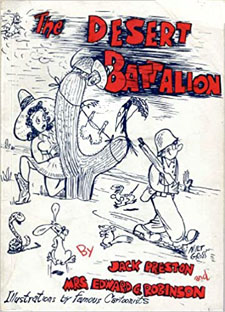 The Desert Battalion by Jack Preston and Mrs. Edward G. Robinson (Murray and Gee, Inc., Hollywood, 1944). There are over a dozen cartoons in this book produced and contributed by the staff of Walt Disney Productions supervised by Don Douglas. (There are also some Milt Gross original illustrations and one unamusing cartoon signed by Roy “Big Mooseketeer” Williams.)
The Desert Battalion by Jack Preston and Mrs. Edward G. Robinson (Murray and Gee, Inc., Hollywood, 1944). There are over a dozen cartoons in this book produced and contributed by the staff of Walt Disney Productions supervised by Don Douglas. (There are also some Milt Gross original illustrations and one unamusing cartoon signed by Roy “Big Mooseketeer” Williams.)
The Desert Battalion was organized in 1942 by Mrs. Robinson and some friends. General Patton at that time was training his tank crews in the isolated deserts of Southern California. So, Mrs. Robinson and friends thought it would be a good idea to ship girls between the ages of eighteen and twenty-five out to these remote areas, where under the supervision of a chaperone, they could boost the morale of the GIs.
This book runs roughly a hundred pages and details some of the adventures and mis-adventures (all PG rated) the girls ran into on their journeys to entertain the troops. The Disney artwork is sometimes wonderful “good girl” artwork done in the spirit of Disney artist Freddy Moore, like the girls in slips and curlers desperately trying to get ready for inspection.
All the Disney drawings feature a copyright for “WDP”. The text tries to stress that these girls aren’t glamour queens but just typical down-home kind of girls, and the Disney illustrations depict cute and perky bobbysoxers similar to the ones in the Disney short All The Cats Join In.
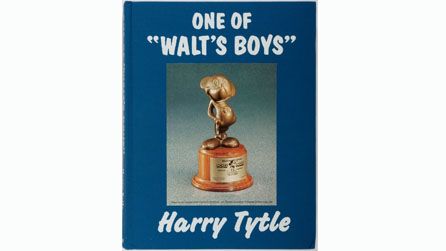
One of Walt’s Boys by Harry Tytle (self published 1997). At the Disney Studios, you were either classified as one of “Walt’s Boys” meaning you worked with him and reported directly to him or one of “Roy’s Boys” meaning you owed your loyalty and work status to Walt’s older brother Roy. Tytle was a producer among other accomplishments (including coming up with the original idea for The Aristocats). Only 750 copies with a blue cover and 50 copies with a red cover (exact same illustrations and text but autographed by Tytle) were issued. Tytle kept diaries of his time at Disney and uses those to great effect in this 241 page hard cover book to tell stories that are still not told elsewhere including ones about animation but from a business perspective. Foreword by Bill Justice.
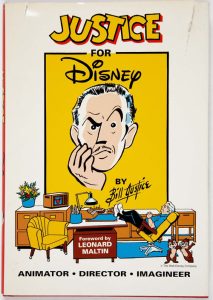 Justice for Disney by Bill Justice (1992 Tomart publications). There is wonderful editing by Bob Welbaum and Tom Tumbusch who wrangled Bill’s original very rough and unfocused manuscript (that I read) into a terrific book. Bill was a talented animator perhaps best known for his work on the Chip’n’Dale characters. He was later moved over to Imagineering where he programmed audio-animatronics for Pirates of the Caribbean, Haunted Mansion, Country Bear Jamboree and more. The book is filled with artwork on almost every page including cartoon illustrations drawn by Bill specifically for this book to relate to the text. This hardcover 168 page book with a dust jacket and a foreword by Leonard Maltin captures the warmth and modesty of the man while revealing lots of behind-the-scenes information about Disney animation and Imagineering.
Justice for Disney by Bill Justice (1992 Tomart publications). There is wonderful editing by Bob Welbaum and Tom Tumbusch who wrangled Bill’s original very rough and unfocused manuscript (that I read) into a terrific book. Bill was a talented animator perhaps best known for his work on the Chip’n’Dale characters. He was later moved over to Imagineering where he programmed audio-animatronics for Pirates of the Caribbean, Haunted Mansion, Country Bear Jamboree and more. The book is filled with artwork on almost every page including cartoon illustrations drawn by Bill specifically for this book to relate to the text. This hardcover 168 page book with a dust jacket and a foreword by Leonard Maltin captures the warmth and modesty of the man while revealing lots of behind-the-scenes information about Disney animation and Imagineering.
These last two books will never be reprinted because Disney gave permission for the use of Disney artwork in these books on the condition that they have limited printings of under a thousand copies and that they never be reprinted. I tried to make arrangements to get the Bill Justice book reprinted during the time he fell ill before his death to help him get some additional money but hit a brick wall at Disney. Anyone still interested in me sharing some more obscure animation related books?
For links for these books – and hundreds of other Disney and Animation books, check our new Animation History Bibliography on Cartoon Research.


 Jim Korkis is an internationally respected animation historian who in recent years has devoted his attention to the many worlds of Disney. He was a columnist for a variety of animation magazines. With his former writing partner, John Cawley, he authored several animation related books including The Encyclopedia of Cartoon Superstars, How to Create Animation, Cartoon Confidential and Get Animated’s Animation Art Buyer’s Guide. He taught animation classes at the Disney Institute in Florida as well as instructing classes on acting and animation history for Disney Feature Animation: Florida.
Jim Korkis is an internationally respected animation historian who in recent years has devoted his attention to the many worlds of Disney. He was a columnist for a variety of animation magazines. With his former writing partner, John Cawley, he authored several animation related books including The Encyclopedia of Cartoon Superstars, How to Create Animation, Cartoon Confidential and Get Animated’s Animation Art Buyer’s Guide. He taught animation classes at the Disney Institute in Florida as well as instructing classes on acting and animation history for Disney Feature Animation: Florida.




















































To me, that cover portrait of Bill Justice looks more like Vincent Price!
Several years before “Ether and Me”, Will Rogers’s book “The Illiterate Digest” was illustrated by newspaper and magazine cartoonist Nate Collier, at the time a much better-known figure than Grim Natwick. In the late teens and early ’20s Collier worked as an animator on Jerry on the Job, Mutt and Jeff, and Paul Terry’s Fables Studio, but he found it tedious and returned to newspaper work. Collier’s two sons, Theron and Thurlo, were both animators at Terrytoons for several years in the 1940s.
Although it’s a bit off the subject, I’d be interested in a history of Disney sheet music. That would have begun back in the early days of Mickey Mouse, with signature tunes like “Minnie’s Yoo-Hoo” (which is surprisingly difficult to sing). My mother had some old vintage editions of songs like “Brazil” and “Tico Tico” that weren’t owned by Disney, but they were promoted with cover illustrations of Donald Duck and Jose Carioca. When I was little we had the sheet music collections of songs from “Mary Poppins”, “The Jungle Book”, and so on. I used to drive my family crazy playing “Colonel Hathi’s March” on the piano over and over and over and over….
Hope you eventually find a copy of that Roy Williams autobiography. Good luck!
It’s Disney’s face on the big portrait, not Justice – who’s the one with his feets on the desk.
Ah, I see. Still looks like Vincent Price to me.
One Of Walt’s Boys:
For me the best book ever written about Walt Disney Productions.
It is a business made bare warts-and-all story of decisions made by him (or with Walt) with the company during his service.
Harry Tytle made many choices which upset many staff members (including myself the reader at times). It is not surprising that he was the model for the traitorous Mr. Winky in Ichabod And Mr Toad”
He was head of the music dept for 7 years prior to Bob Jackman, whilst describing himself as music illiterate.
He was the one responsible for which cartoons aired on the prime time TV show, and which were destined only for daytime viewing (Mickey Mouse Club)
Where else are you going to read FIRST HAND about:
-ABC upset about a program on Tchaikovsky
-cigarette advertising on the TV Show
-story board meetings on Pluto’s Day
and that’s all on one page of his book
Or:
-Lucky Number getting a low quality rating
-The importance of Hal Adelquist
-Walt’s stipulation for cartoon shorts that they stick to 25 of his characters
-More cartoons starring Pecos Bill
-Mickey And The Seal was originally written as Donald And The Seal, but Jack Hannah thought it wasn’t funny enough
-Fred Leahy and Jack Reeder
-The bloodbath meeting of September 4, 1957
-Firing Walt Disney’s relatives
-How they filmed Barry’s monument for Barry Of The Great St Bernard
RE: Justice For Disney.
I bought a second hand copy in 1997 at a Disney Convention (for $105).
I told Bill the next day. He wasn’t surprised at the price, but certainly wished he could have had some of that mark-up.
Actually, I recall Disney Magazine promoted “One of Walt’s Boys” in their Summer 1997 issue (with Hercules on the cover). I didn’t know that book had a limited printing and find it odd the company magazine promoted such a small-run publication. I’d imagine Disney fans found it frustrating trying to find copies of the book after reading the issue.
I have an interesting book about working at Disney by Jack Kinney (“Walt Disney and Other Animated Characters”), Director of most of the Goofy “How To” shorts, as well as “Der Furher’s Face”, the 1942 Oscar winning Animated short. He was friends with Roy Williams since High School.
Thanks for this article, Jim. I would vote for more mini-reviews of obscure Disney (and cartoon related) books. Where can I find a copy of “The Secret World of Roy Williams”? In Harry Tytle’s book, there are stories about how much Walt disliked Goofy! I’m sure Walt would have admitted that audiences liked the Goof, but he personally was not a fan! I really like Grim’s illustrations for “Ether and Me”, they resemble his work in silent animation, such as the Judge Rummy cartoons he animated. I don’t think Grim attempted to animate caricatures, however. They are very hard to do, turnarounds have to be cheated like crazy to work in the 2D/3D world of drawn animation. Grim did the illustration on the sheet music cover of W.C. Handy’s “St. Louis Blues”, and met with Handy personally.
I believe Grim Natwick worked on a number of cartoons featuring celebrity caricatures, such as the final Flip the Frog cartoon “Soda Squirt” and Disney’s “Mother Goose Goes Hollywood”. The depiction of Mae West in the former certainly looks to me like his work. Since he was at the Iwerks studio when the ComiColor cartoon “Summertime” was made, I wonder if he might also have been responsible for the caricature of Will Rogers as a polo-playing centaur.
RobGems68 wrote:
Interesting collection of rare Disney-related books you don’t see everyday on the market. Anyone know who’s the girl in the sombrero on the “Desert Battalion” cover?
Slue Foot Sue?
RobGems68 wrote:
Maybe. I suggest that the girl is anonymous, then. She sure is cute, though.
YES! More articles like this, please!